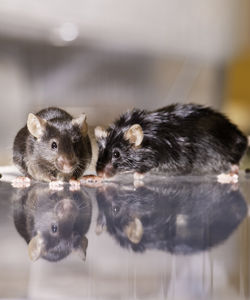This website uses cookies to ensure you get the best experience on our website. Learn more
This test evaluates body-mass progression with age. The frequency of body-weight measurement depends of client's requirements.
![]() Body weight progression under CD between different strains of female mice
Body weight progression under CD between different strains of female mice
![]() Body weight progression under CD between different strains of male mice
Body weight progression under CD between different strains of male mice
8 mice per group are recommended for reliable data analysis.
The test is performed to examine morphological abnormalities with respect to general physical appearance and body shape on mice: weight, length, and obvious dysmorphologies in the physical appearance, i.e. tail kinks, shape of ears, eyes, head, teethes, limbs, number and shape of digit, irregularities and variation in coat color, hair distribution and development, irregularities in the genitals (Fuchs H, et al., 2000).
![]() Body temperature in different mice strains
Body temperature in different mice strains
8 mice per group are recommended for reliable data analysis of temperature and body-weight parameters.
The test gives precise analyses of the body composition with respect to fat content, lean tissues and free body fluids in a mouse.
Body composition is evaluated by Quantitative Nuclear Magnetic Resonance (qNMR) using Minispec+ analyzer (Bruker BioSpin S.A.S., Wissembourg, France)
8 mice per group are recommended for reliable data analysis.
Food consumption is measured by manually weighing remnants of food in the feeders. The test gives precise or estimate evaluation of energy intake in mice depending of whether the animals are singly or socially housed. Food consumption (and water consumption) may also be assessed more accurately in metabolic cages or in polymodal indirect calorimetry monitoring system (see below).
Metabolic and diuresis cages (Line 3, Techniplast).
8 mice per group are recommended for reliable data analysis.
Calorimetry cages allow the simultaneous measurement of energy expenditure, ambulatory activity as well as food and water intake. Energy expenditure is evaluated through indirect calorimetry by measuring oxygen consumption with an open flow respirometric system. It also monitors CO2 production, thus the respiratory exchange ratio (RER) and finally heat production can be calculated. Infra-red frames are integrated to the system in order to measure ambulatory activity. A food intake monitoring system is also integrated for the measurement of feeding/drinking behaviors.
Experiments can be performed from 24h to 5 consecutive days.
The test can be conducted at different ambient temperature (4°C to 39 °C) and the cages allow one to performing food and drink restriction procedures as well as food or drink preference assays.
Home cage system (12 cages) (TSE LabMaster systems GmhB, Bad Homburg, Germany)
